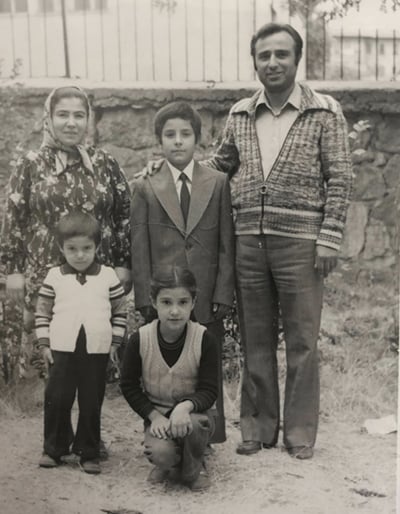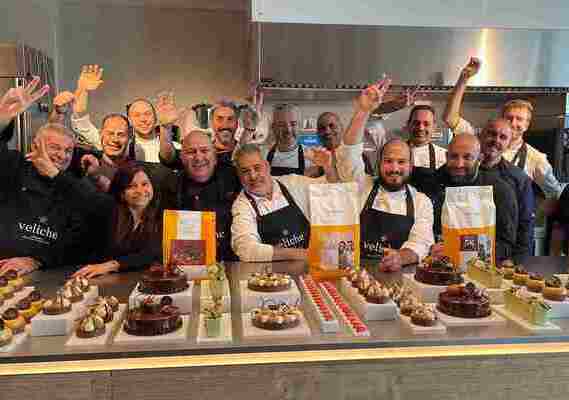A ‘sommelier of food’: Meet Cargill sensory expert Neşe Tülay
Read Time: 5 minutes
May 02, 2024
Give Neşe Tülay a bite of your favorite snack, and she can likely tell you why you love it.
It’s not magic. It’s Neşe’s unique skills, including her natural sensitivity to smells and tastes, and her deep expertise as a food scientist.
As a child in Türkiye, Neşe often wondered about her heightened sense of taste and smell. Today, she’s turned that wonder into a 22-year food science career, including 17 years at Cargill.
“I was fascinated by changing flavors,” Neşe recalls. “Like tomatoes — they taste one way when they’re raw, but so different when they’re cooked. I always wondered what was happening there, in the pan or in the oven, when food is being cooked.”
As head of sensory and consumer sciences for Cargill’s Research & Development team in North America, Neşe leads a group of sensory scientists and trained taste panelists who evaluate our products. The goal? To help our customers formulate foods and drinks that consumers will love.
“Whether you’re launching a new product, developing a new ingredient for a customer or coming up with innovative alternatives that can benefit consumers, we make sure that Cargill provides the right solutions to make products taste good and ensure consumers will buy it again and again,” she says.
“For instance, we recently helped a big oil customer determine how long the cooking oil they purchase from us can maintain quality and taste. We measured how the intensity of each aroma, flavor, texture and mouthfeel attributes changed over time during frying and how much those changes impacted consumer acceptance of the fried food.”
What’s it like to be a sensory expert? Learn how Neşe got into the field, what surprised her and why her kids get annoyed with her when they’re grocery shopping.
Q: What drove you into food sciences?
A: When I was growing up in Türkiye, I wondered why I could not stand spicy food. I would be in pain, burning up at the dinner table while people next to me would be enjoying themselves.
I wanted to understand why some of us experience different sensations from the same bite.
On top of that, I have a lifelong passion for science, technology, engineering and math (STEM). In food science, I could fulfill my interest in math and science, and it also seemed like a great way to apply that to real life.
I would later understand that my reaction to spicy food is because I’m very sensitive to bitterness. As it turns out, capsaicin — a chili pepper extract — can evoke a bitter taste. I love learning things like that.
 Neşe (front) and her family in Ankara, the capital city of Türkiye, where her mother and brothers still live. The photo was captured in September 1980.
Neşe (front) and her family in Ankara, the capital city of Türkiye, where her mother and brothers still live. The photo was captured in September 1980.
Q: How does your team figure out what flavors go well together?
A: Let’s say you’re making a smoothie at home. You’ll probably use whatever fruits you have and see if they go well together.
We go a little deeper with experimental design. We prepare several options of smoothies with different ratios of, say, banana and strawberry. Our trained taste panelists then try those smoothies and provide feedback that helps us determine the optimum flavor profile.
Q: As you started working in this field, what surprised you most?
A: I guess I hadn’t realized how important taste is for people. Finding and perfecting methodologies to measure, quantify and optimize taste — it’s fascinating to me.
At the same time, I realized I also enjoy working with people. As a STEM student, you’re always analyzing data. You don’t want gray areas; you want results in black and white.
But working with people, especially with trained taste panelists, things are not as straightforward. Their responses could be gray, so the challenge is making sure they are well-trained and that we apply a sound experimental design and the right statistical approach to analyze and report data.
On top of that, I found fantastic colleagues in food science — and even more so at Cargill. My team is made up of people from all over the world, and we are always helping each other out and learning from one another. There’s a sense of camaraderie and having each other’s back that creates a very nice dynamic. That’s one big reason I’ve stayed here for so long.
 Neşe (left) has spent 17 years at Cargill — mainly, she says, “because of the sense of camaraderie with my colleagues.”
Neşe (left) has spent 17 years at Cargill — mainly, she says, “because of the sense of camaraderie with my colleagues.”
Your career in innovation starts here
How does Cargill do meaningful, innovative work with a global impact? We have a team of professionals like Neşe who collaborate on leading-edge scientific research and development. Here's how you can join them.Q: What’s your favorite aroma?
A: I like rose flavors and aromas. In Türkiye, there are lots of rose products — soaps, perfumes, even sweets and jams. But it has to be the natural rose aroma. I can always tell when it’s artificial.
Q: Has your knowledge and expertise changed how you eat at a restaurant or buy groceries?
 Neşe and her daughter Sila wearing traditional Turkish folk dance dresses.
Neşe and her daughter Sila wearing traditional Turkish folk dance dresses.
A: Oh yeah, big time. As a food scientist, I’ve always read the ingredient list of anything I buy. Now I’m teaching my kids that, if the first ingredient in a snack they want is sugar, then we’re not buying it. They find me so annoying!
Going to a restaurant can be a difficult experience. I’m very picky, but I try not to bother anyone. The other day, we were out with some friends, and I ordered fish fingers. Oh my gosh, just by looking at them I could tell they were cooked in really old oil.
In social settings, I try not to bias people and just keep it to myself.
Try this expert sensory test and learn the power of smell
Did you know your sense of smell and your favorite flavors are linked? Flavor is the combination of taste and aroma. Want more proof? Here's how Neşe suggests you can test it out for yourself:
- Grab a piece of milk chocolate and place it on your tongue.
- Give your nose a squeeze and hold it for 3 seconds.
- As the chocolate starts to melt, notice what you are experiencing — probably only a sweet taste.
- Now, release your nose. Take note of how the chocolate aromatics will fill your nose, giving depth and subtle notes to the chocolate flavor.
More stories
Sweet! From ‘Best pastry chef in the Netherlands’ to Cargill’s House of Chocolate, meet Chef Peter
Veliche’s gourmet advisor shares the culinary credentials he uses to craft confections for Cargill customers
‘This is how we eat’: An intern’s journey into food production
Two-time intern Darrin Adams shares his experience as an operations management intern at Cargill.

His Cargill career? 47 years (and counting). Meet Lyle.
His career began as a janitor. He became a bilingual leader at our largest plants in Brazil. What makes Marconi Vieira proudest?


